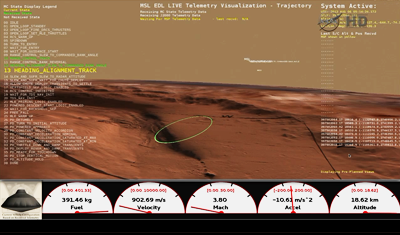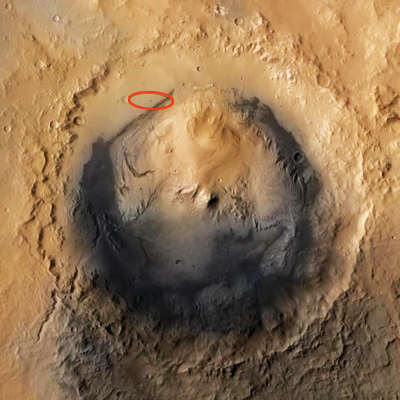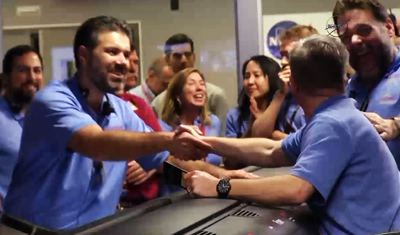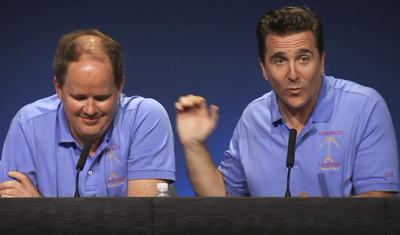 Curiosity, the largest robotic rover ever built by NASA, will touch-down on Mars this Monday 6 August 2012. NASA-TV will broadcast the landing “live” from the control room at JPL (low definition here).
Curiosity, the largest robotic rover ever built by NASA, will touch-down on Mars this Monday 6 August 2012. NASA-TV will broadcast the landing “live” from the control room at JPL (low definition here).
The show starts at 4am Monday (UK) or 1pm Eastern US time (5th August). The historical landing is expected to take place at 06:31am.
The term “live” is not quite so accurate in this case, due to the delay of signals reaching our planet. Even travelling at the speed of light, data from Mars takes around 14 minutes to get to Earth. Sending a response or command would take another 14 minutes. This means that everything we’ll see will always be old news.
As two-way communication to control the spacecraft remotely during landing is out of the question, the next best option was to choreograph the landing based on our knowledge and experience of travelling in space, and trust her robotic capabilities to make adjustments towards a successful touch-down. No room for last minute corrections. No change of plans. No second chance.
This will be it! … The ultimate test to human ingenuity and technological skill ...
Seven minutes of terror
 Curiosity launched from Cape Canaveral in Florida, on board an Atlas V 541 rocket on 25 November 2011. After 8 months and 560 million kilometres across our solar system, it has arrived to its final destination, Mars.
Curiosity launched from Cape Canaveral in Florida, on board an Atlas V 541 rocket on 25 November 2011. After 8 months and 560 million kilometres across our solar system, it has arrived to its final destination, Mars.
On the early hours of Monday 6th August (UK time), she will enter the Martian atmosphere at nearly 20,000 km/h reaching more than 10G of acceleration.
Firing her own Reaction Control Jets, the spacecraft will be able to steer as she crosses the atmosphere engulfed in a ball of fire, resulting from friction of gas particles against her protective heat-shield.
Falling at Mach 2, twice the speed of sound, she will deploy a gigantic 21m-diameter supersonic parachute to slow down her free-fall. With the first glimpse of the ground on her radar, Curiosity will calculate her speed and height to separate from the chute and stir away from its path thanks to her Descent Stage vehicle. This vehicle has 8 Mars-Landing rocket engines powerful enough to decelerate down to an amazingly controlled speed of 2.5 km/h.
At 20 metres from the ground at Gale Crater, a bridle will slowly separate the lander from the descent stage and as soon as Curiosity touches Martian terrain, the descent stage will separate and take off to land some distance away.
From entering the atmosphere to touching the ground will take 7 minutes. By the time the news arrive to Earth, the destiny of Curiosity will be sealed. She will be triumphant or dead ... (Adam Steltzner).
The Gale Crater, south of the equator on Mars, was carefully selected as the landing zone. A team of specialist in trajectory and navigation have the task of steering the spacecraft towards that target.
 After a few recent adjustments the spacecraft is bound to enter the atmosphere at the precise point and land as close as possible to the chosen point. This is a complex and difficult calculation task, considering the distance away from Earth and that the only means to calculate positions in space is from data sent by satellites near Earth.
After a few recent adjustments the spacecraft is bound to enter the atmosphere at the precise point and land as close as possible to the chosen point. This is a complex and difficult calculation task, considering the distance away from Earth and that the only means to calculate positions in space is from data sent by satellites near Earth.
Tomas Martin-Mur, Navigation Team Chief, compares this task to steering a racing car based on the position of distant buildings that you can only see through the back window.
Another JPL team, led by Ashwin Vasavada, is in charge of forecasting weather conditions on Mars with the help of the Mars Reconnaissance Orbiter (MRO). This spacecraft has been orbiting and monitoring the red planet for the last few years, sending temperature readings and colour images, which are now used by scientists to predict the Martian weather.
Mars is currently coming out of its Winter and is therefore expected to be cold and possibly windy. Images of the planet, sent by MRO on 1st August 2012, show water-ice clouds and dust storms. Curiosity is prepared to withstand most climatic conditions that may occur that day.
Another variable to take into account is space weather. Solar flares or plasma ejected from the sun can affect navigation systems on the spacecraft. A number of space probes are constantly monitoring the sun for this purpose.
Eyes on the Solar System
 A scientific group at Jet Propulsion Laboratories (JPL) in Pasadena, California, recently developed a new online tool called “Eyes on the Solar System.” It opens a window into space exploration and features the many probes and missions currently in operation in space.
A scientific group at Jet Propulsion Laboratories (JPL) in Pasadena, California, recently developed a new online tool called “Eyes on the Solar System.” It opens a window into space exploration and features the many probes and missions currently in operation in space.
The programme is an amazing 3-D computer simulation based on current data that allows the viewer to move across space and find out what the probes are doing and where they are.
Curiosity or MSL is one of the highlights, and besides providing real-time positioning in space, it also offers a real-time simulation of the landing on Mars. You can follow all the landing phases in real-time and pause the animation, zoom-in to see more detail and move around at will.
This magnificently produced tool will give space enthusiasts a unique view of the current state of space exploration, and best of all, in true NASA/JPL style, access is free for everyone to use. You may need a modern computer with connection to the Internet and all you have to do is visit their website at http://eyes.nasa.gov
The Mission
 The rover Curiosity is the star of a mission called Mars Science Laboratory (MSL), which was conceived many years ago and is the latest addition to a progressive set of missions designed to reach and learn about our neighbouring planet.
The rover Curiosity is the star of a mission called Mars Science Laboratory (MSL), which was conceived many years ago and is the latest addition to a progressive set of missions designed to reach and learn about our neighbouring planet.
With a price tag of 2.5bn dollars, the MSL project has been quite beneficial to our economy in the last decade. It generated quality employment in science and technology for more than 7000 people in USA and 10 other countries including Canada, Spain, Japan and others. Future prospects to continue space exploration will secure more opportunities around the world.
Doug McCuistion, Mars Exploration Programme Director, based at NASA Headquarters, recently described the last decade of missions as he summarised its achievements:
- 2001 – Odyssey, captured images.
- 2003 - Mars Express, collaborated with the first rovers: Spirit and Opportunity.
- 2005 – Mars Reconnaissance Orbiter (MRO), participating actively in the current mission.
- 2007 – Phoenix lander.
- 2011 – Curiosity the Mars Science Laboratory (MSL).
- 2013 – MAVEN will help understand the past of the planet.
- 2016 and beyond – Human precursor missions.
Curious about Curiosity? >> Read our article Mars Rover – A Science Lab
William Shatner, who played Captain Kirk, commander of the Enterprise on the famous TV series StarTrek, talks about the virtues and the journey of one of the most daring and exciting projects of humankind.
References
¤ Amos, J. (2012) ‘Nasa's Curiosity rover on course for Mars landing’ BBC News. [Online]. Available here. (Accessed: 03 August 2012).
¤ ‘MSL Mission engineering overview’ (2012). NASA. [Online]. Available here. (Accessed: 03 August 2012).
¤ Renart (2011). ‘Mars Rover – A Science Lab’. [Online]. Available here. (Accessed: 03 August 2012).
Images
¤ All images edited by ren@rt. Source: NASA.


![]()










































 Curiosity, the largest robotic rover ever built by NASA, will touch-down on Mars this Monday 6 August 2012.
Curiosity, the largest robotic rover ever built by NASA, will touch-down on Mars this Monday 6 August 2012.  Curiosity launched from Cape Canaveral in Florida, on board an Atlas V 541 rocket on 25 November 2011. After 8 months and 560 million kilometres across our solar system, it has arrived to its final destination, Mars.
Curiosity launched from Cape Canaveral in Florida, on board an Atlas V 541 rocket on 25 November 2011. After 8 months and 560 million kilometres across our solar system, it has arrived to its final destination, Mars. After a few recent adjustments the spacecraft is bound to enter the atmosphere at the precise point and land as close as possible to the chosen point. This is a complex and difficult calculation task, considering the distance away from Earth and that the only means to calculate positions in space is from data sent by satellites near Earth.
After a few recent adjustments the spacecraft is bound to enter the atmosphere at the precise point and land as close as possible to the chosen point. This is a complex and difficult calculation task, considering the distance away from Earth and that the only means to calculate positions in space is from data sent by satellites near Earth.




 The rover Curiosity is the star of a mission called Mars Science Laboratory (MSL), which was conceived many years ago and is the latest addition to a progressive set of missions designed to reach and learn about our neighbouring planet.
The rover Curiosity is the star of a mission called Mars Science Laboratory (MSL), which was conceived many years ago and is the latest addition to a progressive set of missions designed to reach and learn about our neighbouring planet.